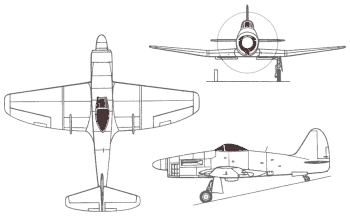



The Westland Wyvern was a carrier-based strike fighter designed for the Royal Navy with the added bonus of being able to carry a torpedo. Although originally designed also for the RAF, only the navalized versions found interest, the result was an aircraft which was larger and heavier than any other British single engined naval fighter before it. Its most distinguishing feature was a pair of contra-rotating propellers powered by Python turboprop engines (the first such British aircraft to operate from carriers) as well as an ejector seat. It entered service only until the mid-1950s by which time it faced stiff competition by more modern jet aircraft which limited its operation to only four FAA front line squadrons some of which saw action during the 1956 Suez Crisis before being retired in 1958, the last fixed-wing design by Westland which then concentrated on helicopters.
Development of the P.10 began during World War II with the first prototype flying on 16 December 1946 followed by the pre-series Wyvern TF.1. At this time it was decided to refit the aircraft with turoprops, resulting in the TF.2 (and a two-seat T.3) which further delayed its introduction in the form of the S.4 which accounted for most examples.
Preceded by:
NoneSucceeded by:
None | |
| Design | Wyvern S.4 |
| Type | Fighter/Attack |
| Year | 1954 |
| Crew | 1 |
| Dimensions | |
| Length | 12.80 m |
| Height | 4.572 m |
| Wing Span | 13.41 m |
| Wing Area | n/a |
| Weight | |
| Empty | 7,080 kg |
| Maximum | 11,113 kg |
| Wing Loading | 337.0 kg/m² |
| Performance | |
| Speed | 616 km/h |
| Ceiling | 8,534 m |
| Range | 1,464 km |
| Powerplant | |
| Engine | 1 x Python ASP.3 Armstrong Siddeley 3,065 kW |
| Thrust/Weight | 0.53 |
| Armament | |
| Guns | 4 x 20-mmHispano Mk. V |
| Payload | 1,361 kg |
| Hardpoints | 3 |
| Production | |
| Built | 94 |
| Total | 127 |